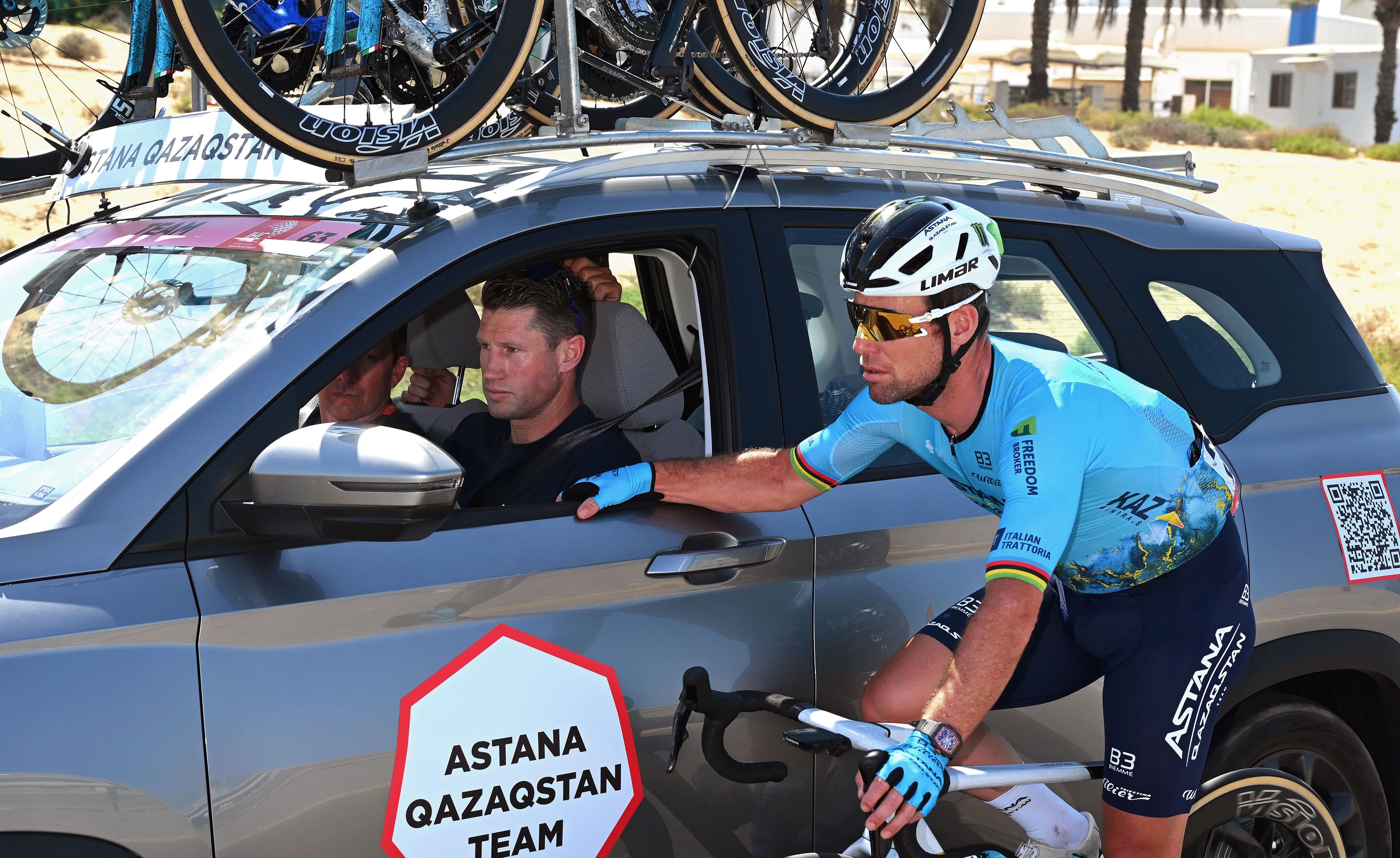Silent Summer: pro cycling and the climate emergency
Will the sport will take responsibility for its huge environmental impact, and if it can survive a changing world?
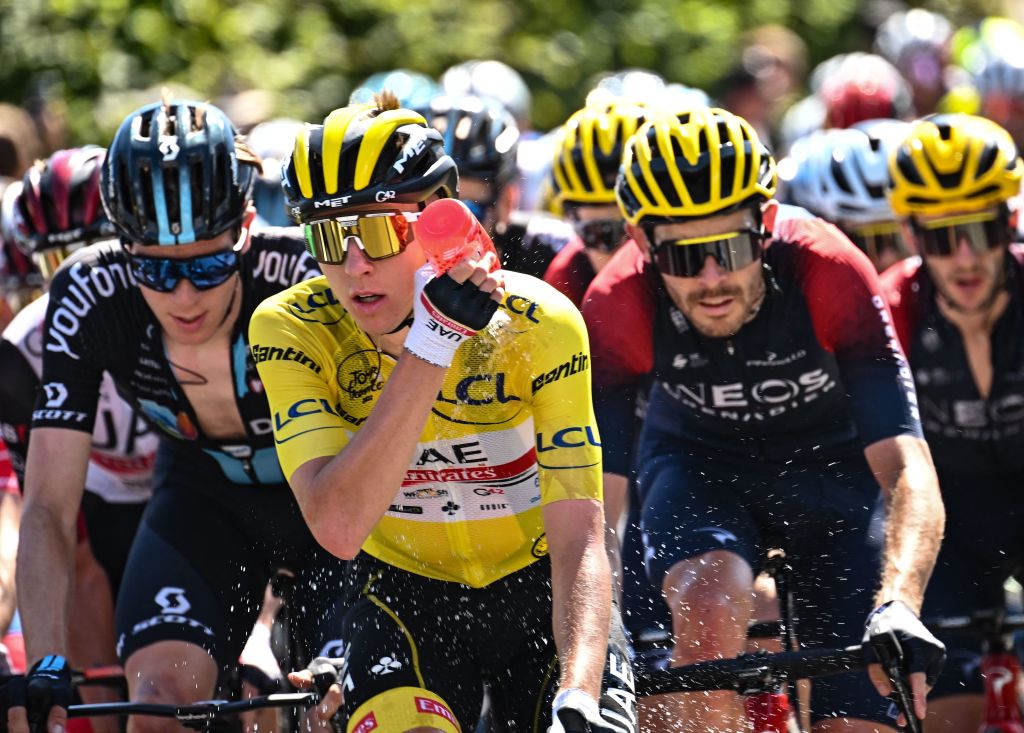
Cycling is one of the greenest things we can do. With transport emissions at an all-time high, millions of unnecessary car journeys daily and scientists warning that the world faces a climate emergency, the bike is one of the solutions. But pro cycling isn’t so green. The sport flies thousands of people around the world and races are uniquely vulnerable to climate change. In this special feature, Richard Abraham asks when the sport will take responsibility for its huge environmental impact, and if it can survive a rapidly changing world at all.
Ice age coming. Let me hear both sides
“It was like a war scene,” Christophe Brandt tells me. “In certain places everything was destroyed by the force of the water. The worst was seeing people taking out everything they had in their houses - furniture, everything - and all of it had been f*cked up by the floods.”
Brandt doesn’t live in the tropics. He doesn’t live on a low-lying Pacific island. He doesn’t even live by the sea. He lives in southern Belgium, where he organises the Tour de Wallonie. The annual five-day race takes place in late July but this year things were different.
“To begin with we didn’t understand the scale of the catastrophe. Then when we started to see places we knew, houses underwater. After that it became a matter of organising a bike race.
The floods of July 2021 broke meteorological records across the region. In Jalhay, just outside the town of Verviers, three times the average monthly rainfall fell in 48 hours. All 200,000 residents of Liège were urged to evacuate. Annelies Verlinden, the Belgian minister for Home Affairs, declared it “one of the greatest natural disasters [Belgium] has ever known”. Forty-two people died in Belgium; across the border in Germany the death toll stands at 184.
Two riders on the start list for Wallonie, Louis Vervaeke and Kenneth Vanbilsen, had begun the week bailing out water from their apartment buildings. Torrents were surging through the ground floor of Le Cheval Blanc, the famous watering hole of the Philippe Gilbert fan club in Remouchamps, at the foot of Liège-Bastogne-Liège’s Côte de la Redoute. The second stage of the 2021 Tour of Wallonia, scheduled for July 21, was designed as a mini Liège running between Verviers and Herve but on the eve of the race, both were up to their necks in flood recovery.
“On the Sunday night before Wednesday’s stage, the mayor of Verviers called and told me the race wouldn’t be possible,” Brandt says. “We started searching for alternatives but the problem is that in order to enact the road closures you need to give four months’ notice. We had two days.”
The latest race content, interviews, features, reviews and expert buying guides, direct to your inbox!
“We keep seeing it in races ... more extremes of weather and temperature. About the events that we saw this year, we can’t do anything. We are just spectators.”
Christophe Brandt
Waters were the problem; Wauters was the solution. Marc Wauters, the Lotto Soudal sports director, manages cycling activities at the Zolder motor racing circuit between Liège and Antwerp. July 21 happened to be a Belgian national holiday and the circuit was free, so Wauters proposed it as a host. A grateful Brandt accepted the lucky break. It wasn’t the most picturesque day’s racing, and it was in Flanders, not Wallonia, but it was at least a race.
“We keep seeing it in races,” Brandt says. “Giro stages that more and more take place in rain and bad weather, more extremes of weather and temperature. About the events that we saw this year, we can’t do anything. We are just spectators.”
The climate is changing. It has changed. It will continue to change. We humans are the reason.
We’ve known this for decades, of course. But the warnings about the extent to which emissions of man-made carbon dioxide and other greenhouse gases will disrupt the planet have recently become impossible to ignore. In its most recent report, the Intergovernmental Panel on Climate Change (IPCC) stated: “It is unequivocal that human influence has warmed the atmosphere, ocean and land.” We now know with greater certainty that such warming is affecting weather and climate across the globe.
The 2015 Paris Agreement commits countries to the aim of limiting warming to 2ºC and to reduce carbon emissions to net zero by 2050. This November, Glasgow will host COP26 where countries are expected to review their progress on the Paris Agreement and commit to enhanced ambition. We know that if we continue with business as usual, the globe will warm by between 2.5ºC and 5ºC by the end of this century. The hotter it gets, the worse the effects.
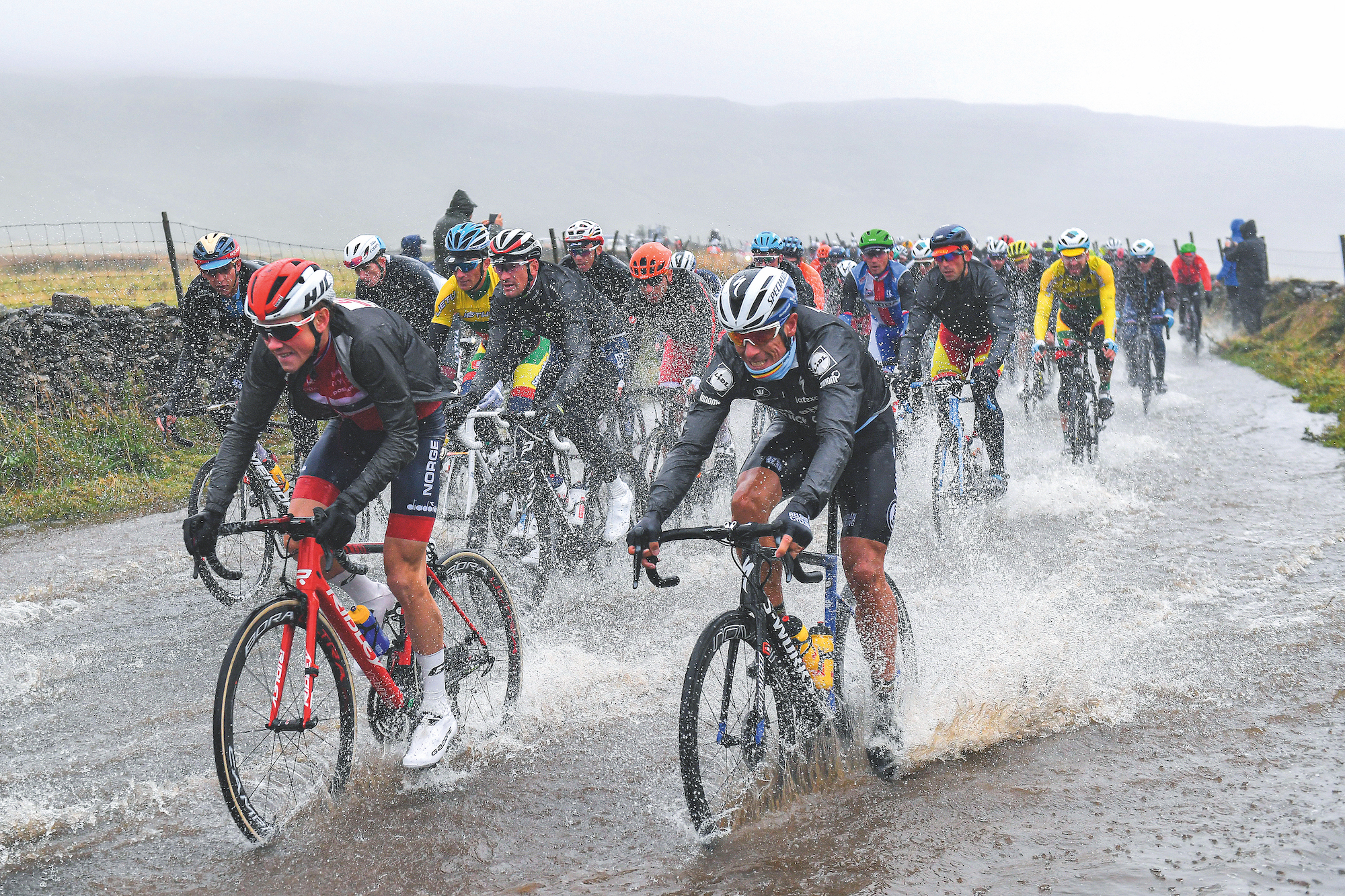
We are in a climate emergency.
The effects of this climate emergency are all around us. Take a breath of air. That lungful contains approximately 409.8 parts per million of CO2, more than at any point in the last 800,000 years. Extreme weather events are likely to become – or already have become – more common. The rainfall that caused the floods in Belgium and Germany was estimated to have been made nine times more likely by climate change. As I write this article from my temporary home near the Southern Alps in New Zealand I can see the snowline is hundreds of metres higher than it should be for this time of year. The country is emerging from its warmest winter on record; 1.3ºC higher than the long-term average and 0.2ºC higher than the previous record year. That record was set last winter. Its ironies are all around us too. I can walk into town and speak to mountaineers who can recall glaciers that no longer exist as they pack their belongings into a helicopter for another trip into the hills. Ski resorts bemoan the meagre snow base while discussions continue around expanding the nearby airport.
Climate change comes down to a question. Not whether it is responsible for events such as warm winters or extreme floods, because the answer is unequivocally yes. The important questions are: how much, and how serious are the consequences? To that there is no clear answer, although in his article ‘The Uninhabitable Earth’ for New York magazine (and later a book of the same name) the journalist David Wallace-Wells opens his exploration of the effects of climate change with the following chilling sentence: “It is, I promise, worse than you think.”
I love cycling but I fear for its future. Besides winter sports, no sport is as chronically exposed to the worst potential effects of climate change. We’ve already seen evidence of this in the landslide on the Col d’Iseran that curtailed the queen stage of the 2019 Tour de France, the race that ITV commentator Gary Imlach boldly called “the first Tour affected by climate change”. We saw it in Tony Martin hiding under a fan’s inflatable lilo as marbles of ice pelted the 2020 Criterium du Dauphiné. The course of the men’s road race at the sodden 2019 World Championships in Yorkshire had to be re-routed at the last minute after severe floods washed away a bridge. Organisers of this summer’s Vuelta a España barred fans from a climb near Alicante due to the risk of forest fires and Chris Froome, or ‘this local cyclo-tourist’ as French TV had him, was turned around on a training ride as police closed roads around Nice for the same reason. Researchers in Belgium recently showed that spring has been happening earlier in recent years by using archive footage of the Tour of Flanders to track green leaves on certain trees regularly passed by the race.
We can’t see or smell or taste CO2, and we can’t attribute the emissions from one budget flight from Girona to Brussels to one Belgian family losing their possessions to the deluge. Perhaps the climate crisis could be solved much more easily if we could. Yet when one considers climate change, professional cycling is almost indefensible. It’s borderline criminal.
The act of racing – the flights, the vehicles, the consumption – contributes significant carbon emissions in itself. These emissions pale in comparison to those of industry, transport and farming across the globe. Yet the sport exists to promote the sort of capitalism and extreme consumption which many observers identify as the cause of the climate emergency and which must be tackled if humans are to limit temperature rises and stave off the worst effects of climate change. The Tour de France was founded to sell papers, its caravan designed to sell other stuff. The teams that compete owe their existence to the concept that you, as a fan, are a consumer and by watching the sport you will go and buy things. Maybe it’s a Grenadier 4WD vehicle. Maybe it’s a holiday to the UAE. Laminate flooring. A bike. A kitchen. Has anyone worked out what NextHash do? One of those.
I love cycling but it has to change. It can’t continue as it has. It is part of the problem. At the same time, the sport has influence. It can inform and inspire action like little else. In its heart sits the closest thing to a silver bullet that the world has: the bicycle. Pro cycling can be part of the solution too.
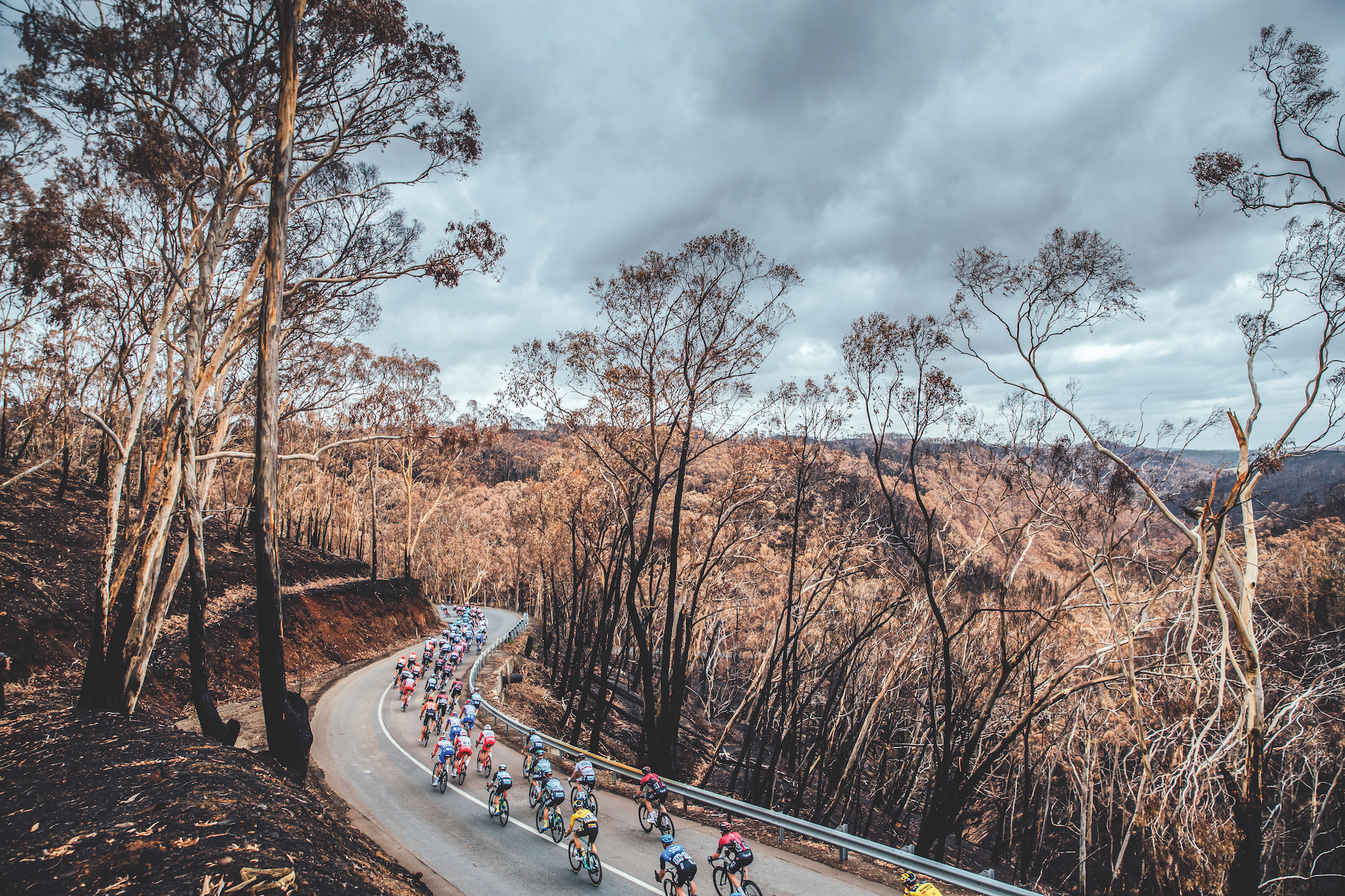
Hopelessly passing your time in the grassland away. Only dimly aware of a certain unease in the air
Let’s begin in Australia. Because we have to begin somewhere, and because some of the most striking images of the new world facing the sport were captured at the 2020 Tour Down Under. The peloton snaked its way through the charred skeletons of forests ravaged by the Australian bushfires. The worst of ‘Black Summer’ was focused on the states of New South Wales and Victoria but experts expect it to amount to Australia’s costliest ever natural disaster. It was an ecological catastrophe and air quality became hazardous across the country. Smoke could even be tasted in the yellow air of New Zealand and it drifted as far away as Argentina. In South Australia at the TDU, riders commented on the unnerving experience of riding through what looked like Armageddon. Sam Bennett described it as like “something out of a film about the end of the world”. The sport, it seemed, was waking up.
The TDU is an established WorldTour event with men’s and women’s competitions, typical of professional road cycling. With its experiences of bushfires and extreme heat, the race has been near the frontline of the climate emergency for years. Flying a largely Eurocentric peloton Down Under is, however, likely to make its carbon emissions higher than the average race.
I contacted the organisers of the TDU, former rider Stuart O’Grady and experienced ex-pat American race organiser Kimberly Conte, to get their perspective on how the race was faring faced with the climate emergency.
“It was really an emotive time,” Conte says, recalling the aftermath of the 2020 fires. “When they allowed us to go in [to the affected areas] I made a beeline to a spot that I had been to only a couple of weeks earlier to do a promotional video. I found the houses, the vineyards, everything gone.
“Australia becomes a home away from home for most of these teams. It was so familiar to them that it had more of an impact, it felt as if part of their home was burning. I think riders are really aware that they have an essential role in communicating sustainability in sport.”
Conte explains that once the safety of residents had been assured, organisers rushed to assess the safety of the scorched tarmac to host a race and sought permission from the affected communities to carry on with their plans, which they universally received. Teams, sponsors and organisers donated time and prize money to the communities.
The TDU, like most stakeholders in pro cycling, is a business. It assesses the risks it faces and takes steps to mitigate them. The events are well versed when it comes to operating safely in hot weather. Organisers have had to modify or shorten stages for this reason in 2017, 2018 and 2019. Yet when it comes to assessing the longer-term future for the event – for instance, the likelihood of hot weather or severe bushfires fatally harming their business – the organisers are less sure. Both Conte and O’Grady have spent their careers in the sport, going back to the same locations at the same time every year, but neither could identify any long term trends from their own experience. It’s a hallmark of climate change; trends are difficult to detect, where they exist at all.
But nor had they sought scientific projections for future climate around Adelaide, where the race takes place.
“I can’t predict the weather,” says O’Grady. “We had the mildest summer for many years this past summer. We can’t control the weather, that’s a pretty tricky question to answer.”
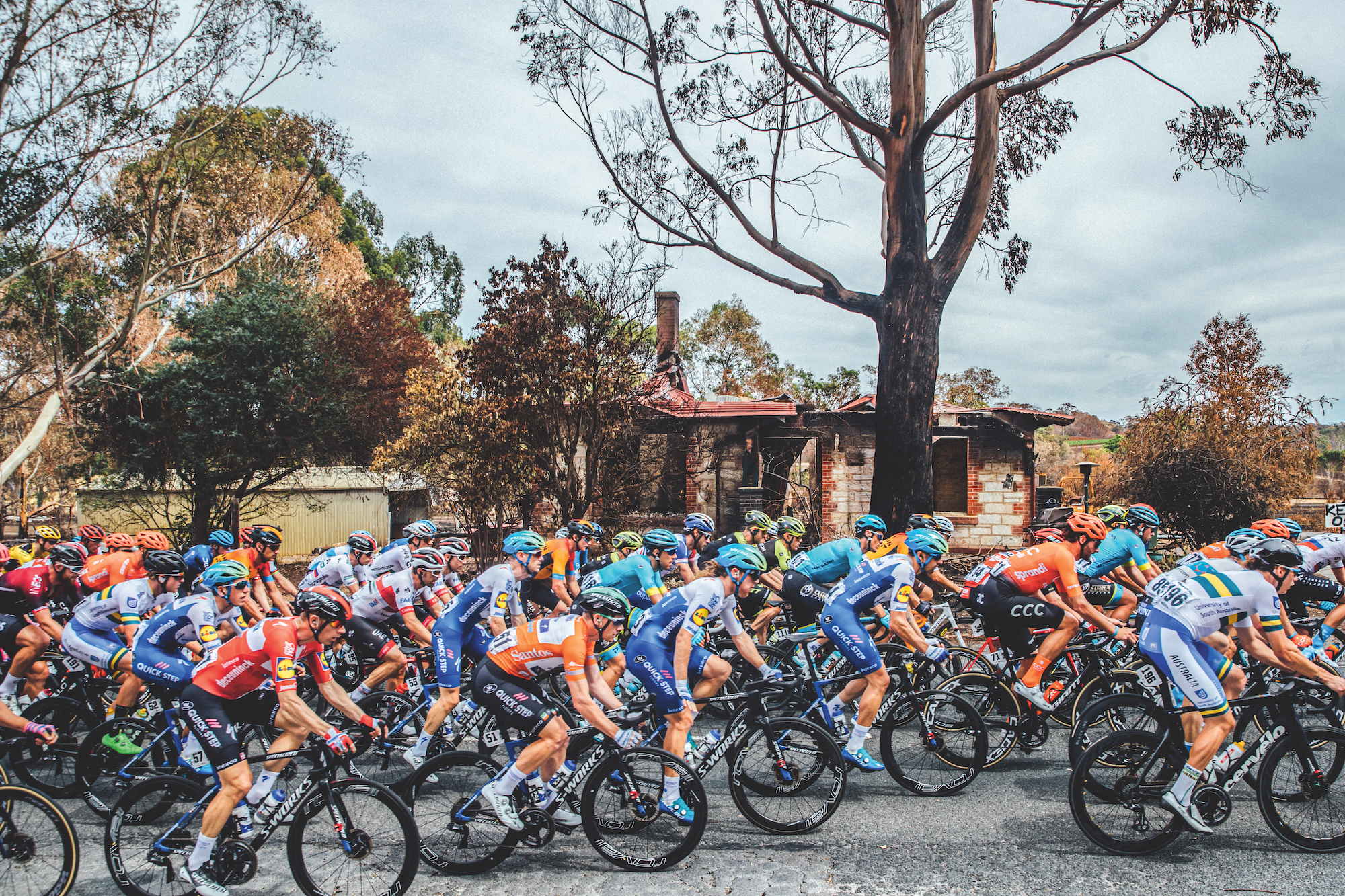
In 2020 the Australian Conservation Foundation calculated that if the TDU was mandated to adhere to Cycling South Australia’s strict rules on competing in extreme heat, not the flexible ones of the UCI, individual stages would have been cancelled 15 times in the race’s history. It noted that Adelaide will see a significant increase in the number of extreme heat days over the next 40 to 60 years and also noted the adverse effects of bushfire smoke on athlete health.
When it comes to calculating its own carbon emissions or taking steps to reduce them, the TDU has no set figures nor targets for reduction but “continuous improvement on environmental impact” is part of its management plan. That plan, Conte says, has been largely focused on reducing waste. O’Grady was keen to stress what he believed was the minimal impact of the sport’s emissions and its positive impact in promoting cycling as an everyday activity.
“Everyone’s working towards a common goal. I think we’re doing everything we can to look after the planet and help it in the small way we can. Hybrid cars, less littering, we’re doing quite a bit,” he says. “Yes, climate change is happening. I’m not blaming cycling, or road cycling, for adding to that. I don’t think cycling’s carbon footprint is very big at all and I think it’s much more about promoting a healthy lifestyle.”
It was an inspiring but also troubling conversation. The care and attention to the end product was reassuring but it was unclear what the future might look like for the Tour Down Under. Nor was it clear what impact the race had on the planet. O’Grady said, “We’re employed as race directors; we’re just trying to organise the best possible race. We’re trying to work towards the common goal of a greener planet and healthier world.”
I’ll also admit that it was only after I hung up the line with Conte and O’Grady that I remembered the race was sponsored by Santos, Australia’s second largest oil and gas producer. Santos is one of Australia’s worst greenhouse gas emitting companies; it comes in for a lot of flak concerning its environmental impact and the perceived ‘greenwashing’ of that impact by its support of the TDU. The race itself has met with calls to ditch its naming sponsor. My oversight did serve to highlight the ubiquity in pro cycling of the sort of sponsors whose presence causes some serious moral quandaries when it comes to the environment.
I sought clarification from the organisers about the role of Santos in directing the TDU’s policy on climate change. The event is owned by Events South Australia and its executive director, Hitaf Rasheed, said in response: “Similar to major events around the world, this much-loved sporting event has a range of sponsors, including Santos as the naming rights sponsor, and many premier partners, major sponsors, corporate sponsors and supporting sponsors. While none of our sponsors have any direct involvement in the organisation or running of this event, we value these partnerships as they allow the race to continue to grow and elevate the event to a world-class offering.”
The TDU is also part-funded by the SA government, which adds a political dimension to anything it says or does. In order to avoid unnecessarily bashing the TDU, I needed to get a handle on two things: how threatened is the sport, and how much of an impact does it actually have on climate change?
To answer the former, I contacted Professor Alistair Woodward, an academic and lecturer at Auckland University who researches climate science and public health and has worked with the IPCC for 20 years.
Woodward recently co-authored an article pondering when and where we would see the last summer Olympic Games. This year Tokyo 2020 moved its marathon races to the northern Japanese city of Sapporo in an attempt to avoid the capital’s summer heat, but Sapporo experienced a heatwave anyway. Let’s just say, don’t put your money on the Games in 2084 being in Asia, Africa or the Americas.
Furthermore, the study raises serious questions around the viability of hosting the Tour de France in southern France in July and the Vuelta across much of Spain in August.
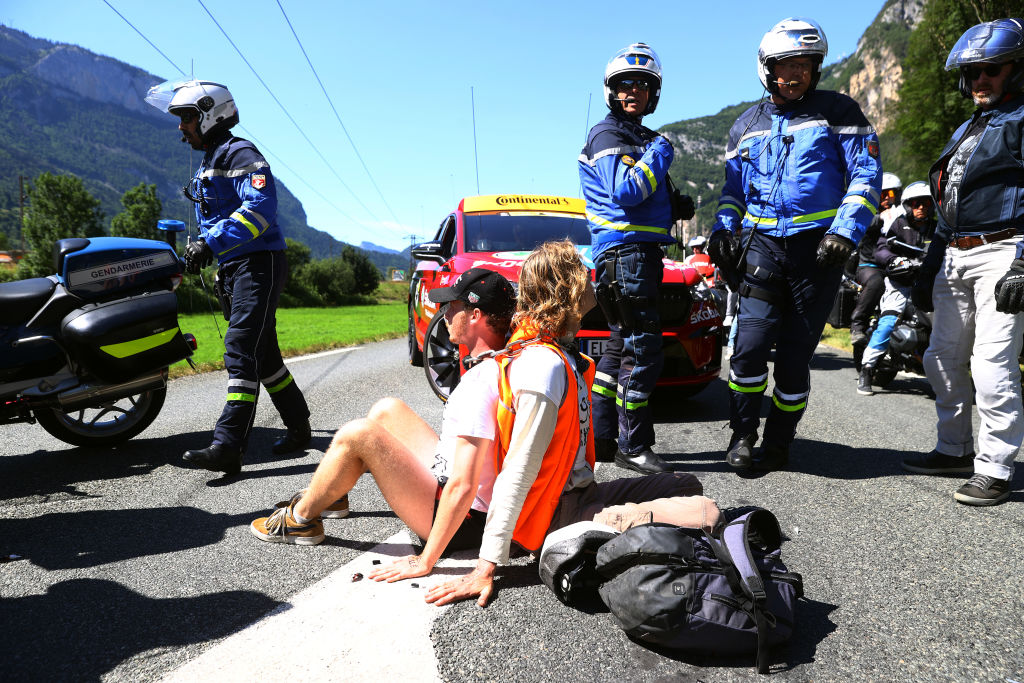
Although professional cyclists are subject to a whole range of environmental stressors – exposure, air pollution, rain and snow – Woodward says the principal threat to the sport comes from heat. No matter how many times a rider trains on the turbo in a home-made sauna, humans have an upper limit beyond which they can no longer keep cool.
“Superbly trained athletes like marathon runners and road cyclists can cope with heat better than most but they can’t ignore it,” Woodward says. This upper limit is dependent on variables like wind, humidity and radiant heat such as from the sun or a black road surface, but if the temperature exceeds a wet bulb globe reading of around 32ºC (this is a way of measuring heat with relation to the evaporation of sweat) “your core temperature will rise, you’ll get heat stress, then heatstroke, then you’ll die.”
Another risk, Woodward ponders, could come from the pernicious impact of temperatures safe enough for competition but high enough to impair function. Much like the NFL and professional rugby’s ongoing discussions around concussion protocols, pro cycling’s fetishisation of suffering could mask serious problems.
“It would be quite plausible that the risk of crashes and the injuries that might follow would also be affected by temperature,” he says. “It has been shown in outdoor workers that productivity falls off as temperatures rise, even before you get to those upper limits, because people don’t think as well, don’t respond as quickly. People are also more likely to cut themselves or fall off ladders when they are overheated and dehydrated.”
The sport’s governing body, the UCI, introduced an extreme weather protocol in 2016 to dictate the response when races come up against inclement conditions that could threaten the safety of riders or personnel. It makes no objective statements as to what is too hot, too cold or too extreme; rather, it leaves the decision on whether to alter or cancel an event up to a group of stakeholders and representatives, including the riders. The ultimate decision is subjective and responsibility rests with the event organiser. This, for Woodward, is problematic, too.
“I don’t know of any other setting in which a decision on safety is made in that way,” he says. “Imagine a coal mine, and deciding whether or not to abandon it because of the risk of fire. Is that decided by a meeting of the mine owner and the union? There are all sorts of risks there, particularly if people feel there is a lot hanging on the results of a particular race or stage.”
Pro cycling is lucky as a sport in that it can move around the globe and the calendar and the clock to avoid extreme conditions, although a crowded calendar and the demands of broadcasters means this is much easier said than done. The information exists to allow event organisers to consider the future impacts of climate change, although they might not have the budgets of the public healthcare systems, militaries and insurance firms across the world that are already stress-testing their systems and responses to hypothetical worst-case scenarios in preparation.
“There are reasonably robust attempts to estimate the future under various climate pathways of extreme events,” says Woodward. “The heatwave underlying the Australian fires of 2019-20 was a once-in-100-or-150-year event in the absence of climate change, but it’s likely to become a once-in-a-decade event if we continue on the pathway that we’re on now. Those sorts of numbers are certainly available and are relevant to professional sport.”
As for the wider societal changes that scientists anticipate will affect global trade, security and governance, only one thing is clear. “There will be a price put on [emitting] carbon and it’s going to go up and up and up, I’ve got no doubt about that. That will become a bit of a threat to high consumption sports.”
When it comes to cycling’s impact on the environment, and what it should be doing about it, I contacted Shift Cycling Culture. Shift is a non-profit organisation aiming to raise awareness and trigger action in tackling the climate emergency, and it wants to see systemic change across the cycling industry. More importantly, they inspire and support companies to do something about it. Shift is working with companies including Rapha, Assos, Schwalbe, Dorel Sports group (the firm behind Cannondale), Le Col, Trek, Specialized and more. The leaders of these organisations are realising, in the words of Jane Dennyson, a professional sustainability consultant who is one of Shift’s directors, that action is no longer a case of a moral obligation but “about no longer having a viable business unless you do something about it”.
Dennyson tells me from Scotland that we should be under no illusion about the severity of climate change. “Only recently have companies started to see climate change as a real risk and understand that this is a strategic issue” she says. “The IPCC report is terrifying. We’ve got a decade to turn this around.”
The first thing professional cycling should do, she says, is calculate its impact on the planet. This is easily enough achieved and there are a lot of companies that calculate carbon emissions. But such calculations for pro cycling are relatively few and far between. The annual footprint of the Tour de France was estimated in 2013 to be 341,000 tonnes of CO2 and a study of its 2007 London Grand Départ estimated that attendees expended enough energy in travelling to the event to run the London Underground for four years. Fifty-nine per cent of them travelled by air. A recent study calculated that every tonne of CO2 emitted would see the global economy £2,170 worse off by the end of the century. Based on this, each Tour costs our great-grandchildren an eye-watering £740m. And that’s just the Tour.
After calculating their emissions, each stakeholder needs to plan for a future affected by climate change, both in operating differently in a changed world and reducing its carbon footprint in line with legislation that countries will be legally bound to implement to comply with the Paris Agreement.
“As an investor I’d ask: have you mapped out what the next 10 years will look like in terms of the projections of climate change and how that will affect your business?” Dennyson adds. “Are you looking, race organiser, at the temperatures in the places you’re racing? Have you thought about how this is going to affect racers, spectators, staff? Is your current business model going to work in five years’ time?
“Everyone has to answer those questions. It doesn’t mean stop doing what you’re doing, it means innovate. This is one of the key messages that we drive through industry. This is about looking at how you do business differently and better. You have to get people excited about this – it’s a real opportunity.”
Cycling faces an existential threat. It also faces an opportunity to innovate. What is it doing about it?
No Music on a dead planet
The music industry shares a number of similarities with pro cycling. A live gig doesn’t emit many greenhouse gases but the act of flying a band and their equipment around the world does. In 2021 the group Massive Attack published the ‘Roadmap to Super Low Carbon Live Music’ as an open resource, having commissioned the research from the Tyndall Centre for Climate Change Research. The band has been offsetting its emissions for a number of years but expressed disillusionment with it, describing it as a way for fossil fuel companies to pass costs on to consumers. The report called for government support and outlined ways to reduce the carbon emissions of tours, from limiting the amount of equipment shipped to switching venues to renewable energy and incentivising gig-goers to use public transport.
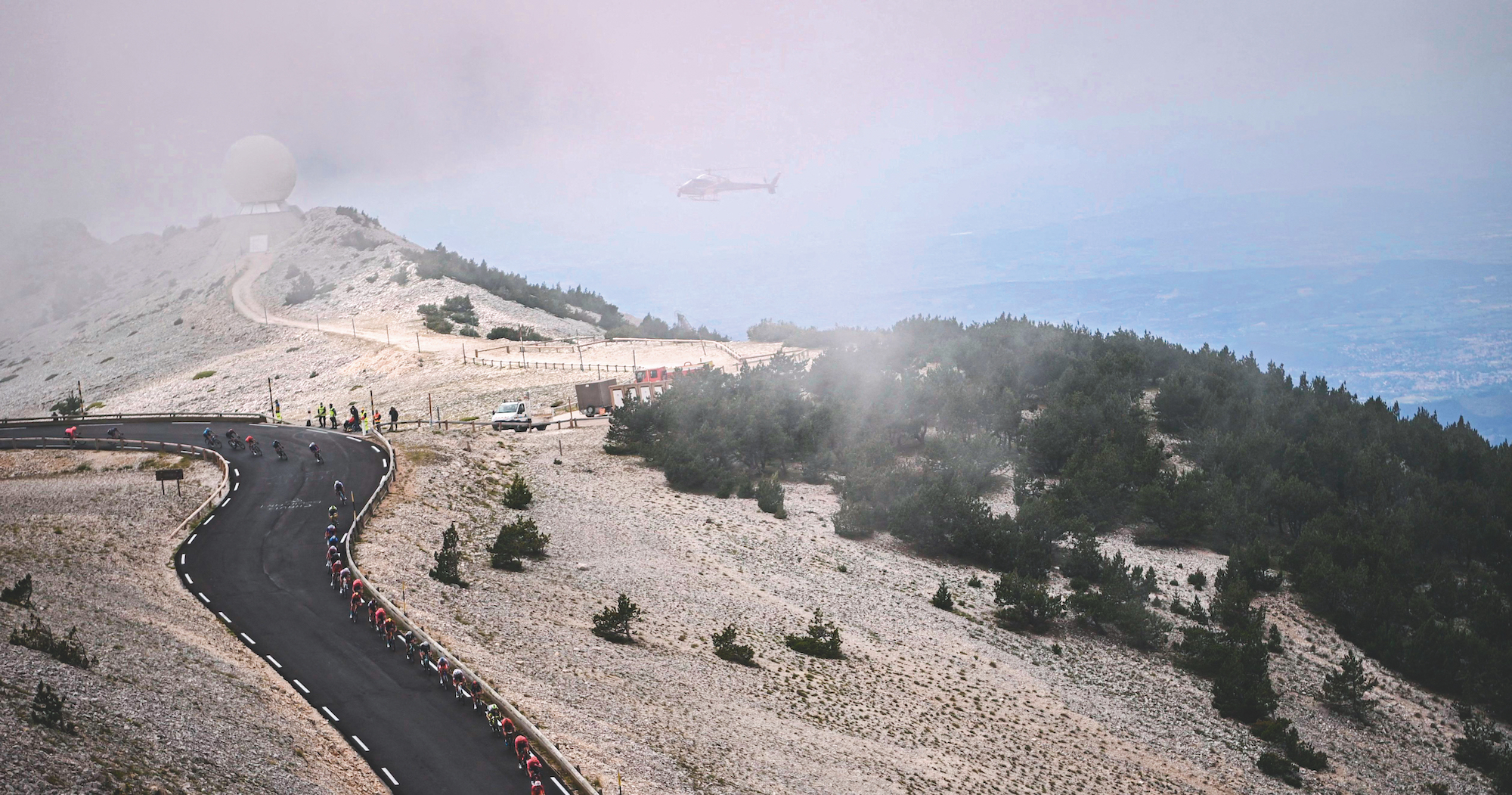
What about this overcrowded land? How much more abuse from man can she stand?
Antoine Geerinckx’s head floats in the azure skies above a lush rainforest in the Democratic Republic of Congo. Because this is 2021, it’s his Zoom background. The forest is a project that CO2logic, the environmental consultancy of which he is founder, has supported as part of its work to offset carbon emissions for its clients. Geerinckx and his company are busy, “finally for the first time in 15 years!” New EU legislation, the European Green Deal, is mandating companies over a certain size to reduce emissions by 55 per cent by 2030. If they don’t comply, Geerinckx reckons, their governments will soon start refusing operating licences and dishing out hefty fines.
One of CO2logic’s clients is Deceuninck-Quick Step. The Belgian WorldTour team contacted the company in 2019 to voluntarily calculate and offset its carbon emissions as part of a wider initiative to raise environmental awareness among its staff, fans and sponsors. It has chosen to support a reforestation project on Mont Ventoux and a clean drinking water initiative in Uganda in what is one of the most visible initiatives taken by pro cycling teams to address the climate emergency.
The team’s own stated impact is quite daunting. In 2019 they rattled through 27,000 plastic bottles, 750 jerseys, 2,500 caps, 180 helmets, 12,500 gels, 280 bikes, 600 chains, 300 groupsets and 400 wheels. I spent weeks bouncing emails back and forth with the team’s communications officer, and at the end of it all I was no closer to an interview with anybody on the team to speak about it, so here I am with Antoine and his head in the clouds.
“The carbon footprint calculation is like the dashboard of a pilot” Geerinckx says. “Know where you stand.” In the case of DQS, their annual carbon emissions totalled approximately 1,280 tonnes of CO2 per year. Over 3,000 football pitches worth of reforestation is needed to offset it, or to continue the flying analogy, it’s equivalent to 1,280 passengers taking return flights from Brussels to New York, demonstrating just how impactful aviation can be. The flying analogy goes even further because in DQS’s case, 90 per cent of those emissions come from travel.
“It will be very much like this for any international sports team,” Geerinckx says.
Therein lies the problem. Current technologies around aviation do offer increased efficiency but as yet no alternative to fossil fuels. The range and charging network for electric vehicles limits their use in a sport where vehicles regularly drive hundreds of kilometres in a day and often undertake spontaneous trips. The sport’s increasing focus on performance gains means teams are using more vehicles – mechanics’ trucks, mobile kitchens, miniature offices and so on – not fewer. Riders live all over the world and rack up dozens of flights per year. Faced with carbon emissions from necessary travel, DQS’s only real solution to reduce its impact on global emissions is to offset. This works by supporting projects that have a net carbon capture, such as reforestation or zero-carbon energy infrastructure.
The clean drinking water initiative works by reducing rural Ugandans’ need to burn wood to boil dirty water. It’s far from ideal. Besides the obvious neo-colonial moral jungle that must be navigated when western companies pay less-developed countries to tidy up after them, many offsetting projects need years before they start to capture carbon from the atmosphere. For example, there are currently no projects in the UK mature enough to sequester carbon today.
Critics of offsetting claim that offsetting can sometimes amount to little more than a token gesture and certainly offers no long-term solutions. The current cost of offsetting projects certainly does little to encourage systemic change, although it is likely to increase. DQS’s offsetting programme costs the team around €15,000 per year, according to Geerinckx, whose company undertake the auditing work pro bono. That’s less than half the annual salary of the team’s lowest paid rider.
“My observation is that the only way to reduce the impact of cycling teams right now is to change the chronology of the main cycling competitions,” says Geerinckx. “Make sure that they follow each other geographically… so you don’t have to fly up and down, move everyone around.
“I think that’s the only solution short term to reduce the impact of cycling. More logical, less flying up and down. When you have to fly, this is where offsetting comes in.”
The biggest concern though is not the players but the spectators. CO2logic audited the Belgian Grand Prix at Spa Francorchamps and found that remarkably, for a sport that flies cars and drivers around the world, the biggest emissions came from fans travelling to the circuit. To the tune of 95 per cent of the total impact. A cycling event like the Tour de France, Geerinckx says, would likely be no different.
Offsetting is at least better than nothing. Collecting the information pertaining to flights, travel and emissions is a costly and time-consuming thing to do, and this alone actually puts DQS ahead of most teams. I contacted every WorldTour team, men’s and women’s, to ask them what their policy was regarding reducing emissions and if there was an opportunity to speak to somebody at the team responsible for it. It was a mixed bag of results and I won’t name and shame them beyond the teams that gave no response at all: Bahrain Victorious, Intermarché-Wanty-Gobert Matérieux, Alé-BTC-Ljubliana and Liv Racing.
Others said they weren’t working on any projects, hinting that financial survival was enough of a job in itself. One press officer was particularly despondent, writing, “Professional cycling is just bad for carbon emissions, because of all the flights to all the races worldwide… It’s not by using less plastic bottles that something will change… I cannot imagine any team has a specific policy. This is not my team’s answer, just a personal note.”
Some had small policies that focused on waste, rather than emissions. One of the world’s biggest budget teams pointed to a project to turn used tyres into belts worn by staff and use paper cups and recyclable cutlery on the team bus. They did email a link to a story about a project where the team manager had been involved with a reforestation project in Mali, but that took place in 2006.
Some say they are looking at reducing their flight load. The SD Worx team’s manager Danny Stam has raised with the sport’s governing body the occasional lunacy of the calendar, such as when women’s teams would travel from Strade Bianche (Italy) to the Ronde van Drenthe (Netherlands) and then to the Trofeo Binda (Italy) in successive weekends every pre-pandemic March.
Some highlighted the individual initiatives of their riders: Guillaume Martin takes the train when he can and Anthony Roux picks up litter on his training rides. One said it has put solar panels on its buses, some are trialling hybrid cars, and another gave a very brief response: “We are using hybrid cars and we are making all the effort about wastes, travels and so on.” Trek-Segafredo, on the other hand, had a comprehensive list that includes switching to hybrid vehicles, overhauling vehicle logistics to reduce travel to and from the service course, which is powered by renewable energy, and various strategies for waste reduction.
The other relative top performers were DSM and EF-Education Nippo, who both calculate and offset their emissions. Movistar is one of the few teams to have a visible sustainability policy; they offset their emissions and 60 per cent of the energy used at their HQ comes from solar panels. Yet the 175 tonnes of CO2 that they offset per year is a long way short of the 1,280 tonnes measured by DQS, likely due to what they do (and don’t) include. I asked Shift for a standard to judge these teams and Jane Dennyson pointed me in the direction of the UN’s Sports for Climate Action framework. According to this, sporting stakeholders should: “undertake systematic efforts to promote greater environmental responsibility, reduce [their] overall climate impact, educate for climate action, promote sustainable and responsible consumption and advocate for climate action through communication.”
Most top-tier cycling teams would find it difficult to say that they comply. An example of what a world-leading sport looks like is Extreme-E, the newly created electric off-road vehicle racing series. The series limits its physical personnel to eight people per team, ships all its infrastructure and vehicles by sea and offsets all of its emissions, which it calculated as around 20,000 tonnes of CO2 per year. It deliberately takes place in places where there will be no fans physically present. The sport says it exists to “highlight the impact of climate change while promoting the adoption of electric vehicles”.
At least that means there was an unintended environmental bonus of hosting bike races in the empty deserts of Qatar. But as for the rest of cycling, oh dear.
Last year Deceuninck-Quick Step announced an initiative by one of its sponsors, the Belgian brewer Maes, to put solar panels on their brewery, cutting a reported 870 tonnes of CO2. This year the team partnered with Ekopak, a water sustainability company. But in general, besides the intangible effect of the sport encouraging people to ride bikes (which it does, to a great degree) any evidence of cycling using its platform to promote greater environmental responsibility is hard to come by.
Professional cycling’s own footprint may be small; that of its sponsors is vast. It’s the elephant’s dirty footprint in the room. Three of the biggest WorldTour teams are sponsored by sovereign wealth funds, with those funds invested principally in fossil fuels. When another, BikeExchange, signed a deal this year with an arm of the Saudi Arabian government, the team’s general manager praised the partnership for its “mutual respect and alignment of values”.
The world’s biggest budget team is sponsored by the world’s third largest oil, gas and petrochemical multinational and named after its new 4x4 vehicle, the presence of which on public roads will do little to promote cycling as a sustainable mode of transport. As Team Sky, it once shrink-wrapped its vehicles in plastic branding to virtue-signal a project launched by its then sponsor to eliminate single-use plastics (SUPs) by 2020. Yet its new sponsor Ineos sits 13th in the table of the top 100 producers of SUPs, which combined are responsible for 90 per cent of global production. That company has also become notorious for its carbon emissions, environmental pollution and for lobbying against green legislation.
When asked what the team’s environmental policy was, a spokesperson highlighted the fact that all kits worn by riders or purchased in the team shop were dispatched without plastic packaging and that “eco-friendly wooden cutlery, paper cups, bags and lunch boxes are used for riders and staff at all races and we aim to recycle our waste where possible, including having recycling bins in race vehicles.
“We recognise our responsibility to minimise our impact on the environment. As a team, we have been prioritising the reduction of single-use plastic in our own operations and promoting cycling as a sustainable transport method for a number of years. We recognise there is always more to do and will continue to learn and work with cycling’s governing body, race organisers and our partners to reduce the sport’s impact on the planet.”
That’s what our cash-strapped, unstable, performance-obsessed sport is up against. The drive for sustainability is just a kid on a balance bike on its way to pre-school, up against the front bumper of the Ineos Grenadier 4x4 which has been “built to tackle challenges head on”.
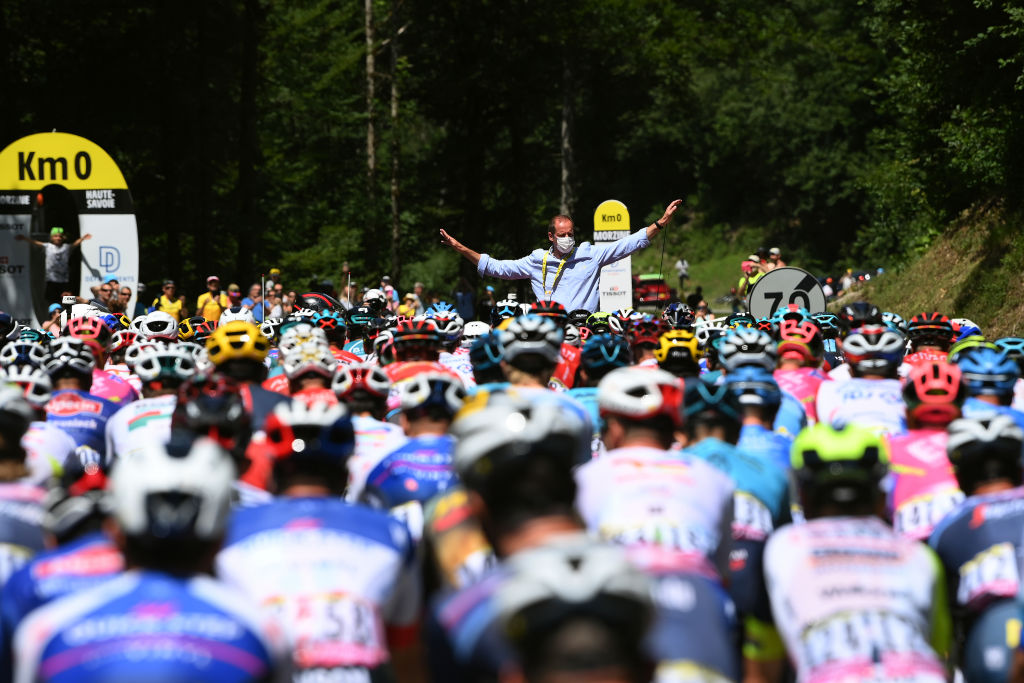
The big wheel keeps on turning. On a simple line, day by day. The Earth spins on its axis. One man struggles while another relaxes
Andorra. The mountain micro-state home to dozens of expat pro cyclists is a land of contrasts. Mike Woods sees them on every ride he does.
“As you ride through Andorra La Vella you’re being bombarded by all these advertisements and you start thinking, maybe I do need a new car, maybe I do need one of those,” he tells me. “That messaging, whether consciously or unconsciously, hits you.
“But when you’re out in the beautiful, natural surroundings you think, well, this is enough. This is what I do enjoy most. Do I need to buy another plastic piece of crap? Is that going to give me the same joy that I’m experiencing here? You can experience that all within one ride.”
Woods is speaking to me from September’s Tour of Britain. Earlier this year he became one of the first professional riders to publicly and unequivocally state a commitment to reducing his impact on the environment, and even wrote a piece for this magazine about it (Perspectives, Procycling 282, June 2021).
Woods calculated and offset his carbon emissions for the pre-pandemic 2019 season using consultants Gold Standard. His footprint amounted to 60 tonnes of CO2, principally from flying (and of that, principally from trips to the Tour Down Under and the Japan Cup). The typical emissions for someone living in Andorra are 12-24 tonnes per year yet Woods is likely to be indicative of a typical male WorldTour rider.
The biggest change, however, has been the lifestyle he and his young family have adopted because “ultimately, it’s industry that’s impacting the environment most and the ridiculous amount of consumerism we have, where people are just buying shit for the sake of buying shit,” he says, emphatically.
It’s not been without the odd dilemma but his public commitment has meant that Woods has become what he terms a “conscious consumer”. He drastically cut back on meat consumption (he is considering going full vegetarian in 2022), buys organic and locally produced food, minimises household waste and commutes by bike. Woods is no evangelical preacher but he is a gentle influencer. His neighbour and fellow rider Robert Gesink, he says, has enthusiastically embraced a similar shift, fitting solar panels all over his house and switching to an electric vehicle. In an unrelated move, Gino Mäder committed to donating a Swiss Franc to sustainability projects for every rider he beat on each stage of the 2021 Vuelta (4,920CHF in total).
“The peloton’s opinions reflect the world,” Woods says. “I’ve had guys who have applauded me and asked how they can help out. Then I’ll show up on the team bus with my permanent bowl and my fork and some guys will be making fun of me, teasing me.
“The goal for me is to normalise being environmentally friendly. I’m not gonna judge the guys that are teasing me, I just hope I can lead by example.”
Woods is proud of his role in stimulating his Israel Start-Up Nation team to begin trialling electric vehicles but voices his frustration that the sport doesn’t use its platform to better influence its millions of supporters.
“Cycling is ultimately this environmentally friendly thing and we as a peloton should be the best representation of cycling,” he says. “When you go to the Tour and see this massive convoy of cars spewing out gas, throwing plastic shit all over the roads, you think well maybe cycling isn’t that environmentally friendly.
“Just because we’re doing something positive in that sense, getting more people on bikes, doesn’t excuse us from contributing to environmental decline.”
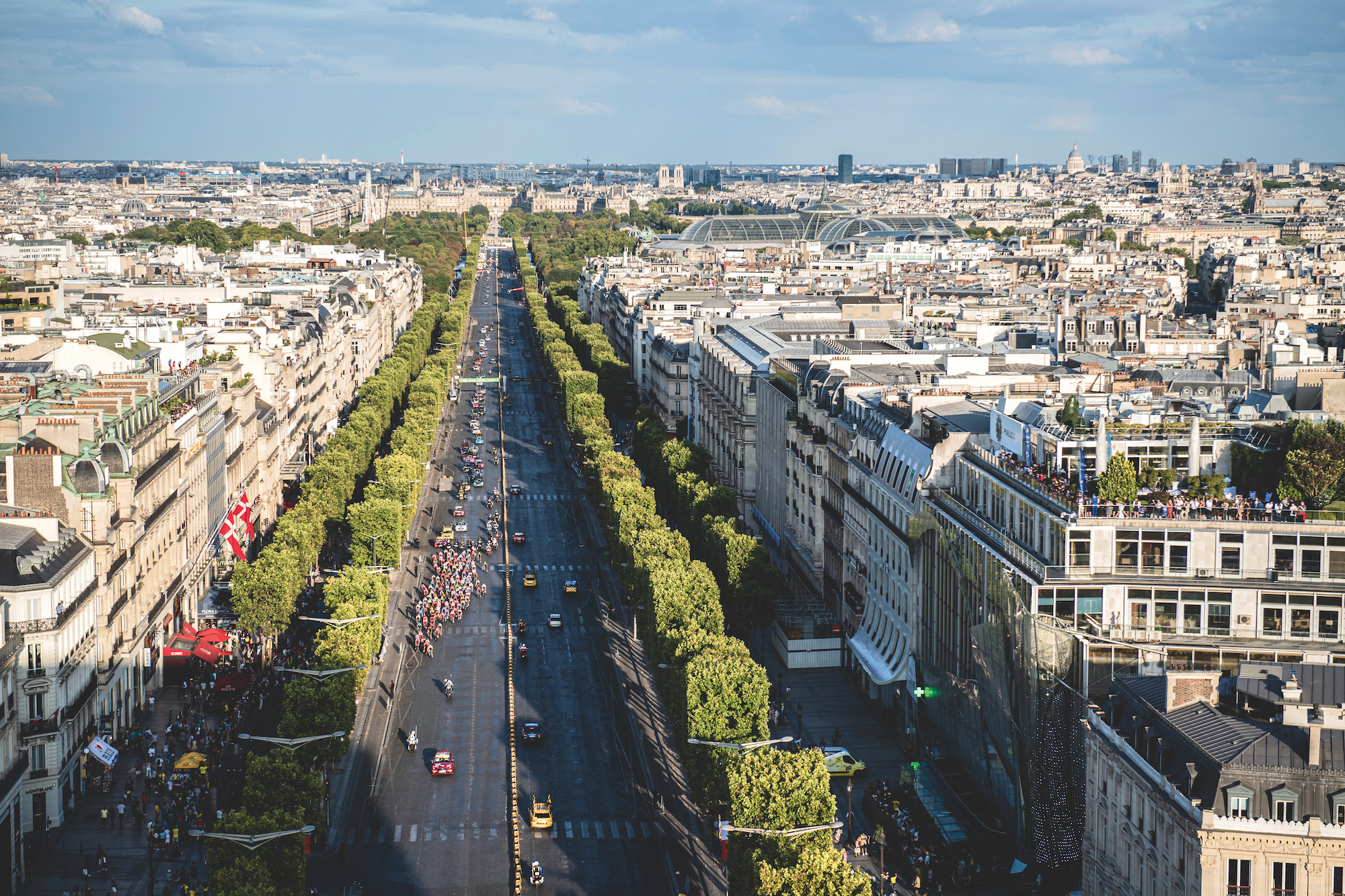
Behold, behold, the heaven-bound seas. The wind cast its shadow and it moves through the trees
Amaury Sports Organisation, ASO, is in the process of calculating the carbon footprint of the Tour de France, having last done so in 2013. Indeed it is calculating the carbon footprints of all 90 of its races and events, from the world’s largest annual sporting event down to the Étape du Tour mass participation ride, the Paris Marathon, the Ladies Open de France golf tournament and the Dakar Rally.
But ASO won’t tell me what the carbon footprint of the Tour is. It probably won’t tell anyone publicly what it is, says Karine Bozzacchi, in charge of corporate social responsibility for ASO’s cycling division.
ASO is owned by the Amaury family as part of the Groupe Amaury that also includes L’Équipe newspaper. ASO is the major player in the sport of pro cycling, its de facto authority, thanks to the monopoly it holds over the sport’s centrepiece event and stakes in over 20 more events across the calendar and the globe. From Paris-Roubaix and Liège-Bastogne-Liège to the Vuelta a España, the Saitama Criterium in Japan and the Tour of Oman, ASO is at the controls. It runs some of the biggest women’s races too: women’s editions of Roubaix, Liège, La Flèche Wallonne and, from 2022, the Tour de France Femmes.
The secrecy around its emissions is surprising given that ASO has come in for recent criticism concerning the carbon footprint of the Tour. In 2019, French journalist Patrick Chassé accused the Tour de France of being “in denial” about its environmental impact after he tried to report on it using only public transport and a folding bike (spoiler alert: it was almost impossible). Karine Bozzacchi responds to that accusation by saying that at the time, the communication around the work ASO was doing on the environment was lacking, yet maintains that releasing emissions data around the impact of the race is unnecessary.
“We are a big event and it’s always big figures,” she says. “People don’t really know exactly what it represents, X million tonnes of carbon. What is important is the improvement between last year and this year, what we have done, what we will do. That’s better than having figures.”
Bozzacchi does admit that the Tour’s annual footprint is between a sixth or a seventh of the carbon footprint of the Olympic Games. Given the Tokyo Games was estimated to account for 2.3 million tonnes of CO2 emissions, that puts the Tour between 329,000 and 383,000 tonnes of CO2, about in line with that 2013 estimate.
If we take 356,000 tonnes as the Tour’s mid range and the carbon emissions of France as 5.19 tonnes per capita, the carbon emissions of the Tour are equivalent to 68,500 French people in a year. Funnily enough, that’s almost the exact population of Issy-Les-Moulineaux, the Parisian suburb where ASO was until very recently based.
ASO has done much to clean up its act. Its ‘Riding into the Future’ programme donates 600 bicycles a year and promotes cycling in towns and cities in Europe. It has a comprehensive waste management plan and 85 per cent of the Tour’s fleet of Skodas use alternative fuels. It claims to have eliminated all the unnecessary single use plastic packaging from the Tour’s 160-vehicle strong publicity caravan. It says it has offset all of its emissions “attributable to the organisation”, which Bozzacchi confirms includes everything necessary to organise the race: the ASO organisers and their vehicles, the infrastructure and logistics teams, the participating cycling teams and the police and security squadrons. It doesn’t include emissions related to sponsors, the publicity caravan, guests and VIPs, or the 3,000-strong media pack, the Tour’s “largest family” and a vast source of emissions. Nor does it include fans, either on the roadside or watching on TV and online, which is likely to be even vaster.
Currently ASO’s target is to have all of its vehicles using alternative fuels - electric, hybrid or bio-fuel – to coincide with the Paris Olympics in 2024. It doesn’t have plans beyond that date. What it won’t do, Bozzacchi assures me, is alter the nature of the competition or the event. ASO is not considering reducing transfers between stages and the publicity caravan is here to stay. As for the future of a race faced with a changing climate, Bozzacchi says “I don’t know how we could integrate these risks at the moment.”
To assess ASO’s efforts I got back in touch with Shift Cycling Culture. Erik Bronsvoort is a director at Shift and a founder of Circular Cycling, a start-up working to develop a circular economy in the cycling industry. He says that greater transparency would go a long way to help identify the sport’s big challenges and encourage creative problem solving.
“If cycling as a sport wants to become serious about reducing emissions in line with the Paris Agreement, we will need to make big changes to how we organise it,” he adds. “Technology can play a big role. Think about creating a full fleet of hydrogen trucks, buses and cars for the Tour caravan, supported by a mobile hydrogen fuelling station. Or the use of drones instead of helicopters, which could create a low carbon alternative with exciting new ways of capturing the race.”
The sport’s ultimate authority, at least officially, is the UCI. Beginning where I left off with ASO, the UCI has identified only that the “likelihood of cycling events being disrupted, cancelled, abandoned due to weather will increase as will the risk of extreme heat impacting athletes’ health, wellbeing and performance”. I asked the sport’s governing body for data on how many days of racing had been affected by its extreme weather protocol since it was introduced in 2016 but this was unavailable.
The UCI is currently undertaking an audit of its own carbon footprint and has committed to being carbon neutral with a 45 per cent reduction in emissions by 2030 in line with the Olympic movement and other federations. This year’s Road Worlds in Flanders had a large sustainability policy and plans to work with consultancy firm Deloitte to assess the efficacy of its efforts and provide a framework for future events. Having signed up to the UN Sports for Action framework in 2020, the UCI updated and extended its guidelines for cycling this summer.
Those guidelines boil down to creating a green agenda in the sport, more or less from scratch. The next steps will include targets for stakeholders and an in-house carbon calculator that will allow them to calculate their emissions. But targets for emissions reduction cannot be implemented without consultation, and there are currently no plans to make environmental action compulsory, or include it in criteria it assesses when awarding licences to teams or classifications to races.
“The UCI has to step in and act as that leader, provide that impulse to teams, organisers and national federations to make sure we all work towards that,” says Isabella Burczak, the UCI’s lead on sustainability and corporate social responsibility. The same applies to potentially troublesome sponsorships from the perspective of the climate emergency. Ambition and leadership, but no concrete rules.
“Given that cycling relies on sponsorship and having released the guidelines, our ambition would be that it might actually encourage new commercial partners to come on board and be a part of this journey, and they might have new ideas to contribute to the cycling world,” Burczak says.
The UCI admits that changing the sport will take time. Instability, fragility and financial precariousness are cycling’s hallmarks. However Burczak says that the recent pandemic shows the sport’s capacity to make big changes in a small space of time.
“One example we can base ourselves on is what happened with Covid-19 and how quickly cycling adapted in terms of changing the way races were organised,” she says. “We’re hoping we can follow this dynamic, apply this to climate change and quickly bring in changes that can also ensure the sport innovates and changes in line with what needs to be done.”
Back with Erik Bronsvoort, who believes the UCI could create more momentum when it comes to reorganising the sport and redefining its equipment standards, which have a large impact on the carbon- and pollution-heavy cycle manufacturing industry. Yes, bikes are green, but there is still an environmental footprint.
“This is a wild idea, but worth exploring,” he says. “Say from 2025 onwards, all teams have a set carbon budget, which will get smaller every year. Every flight or car journey eats up this budget until it is gone and the teams can no longer emit any more carbon. It would definitely make logistics more complicated but in order to make a systemic change, we need to come up with real solutions.”
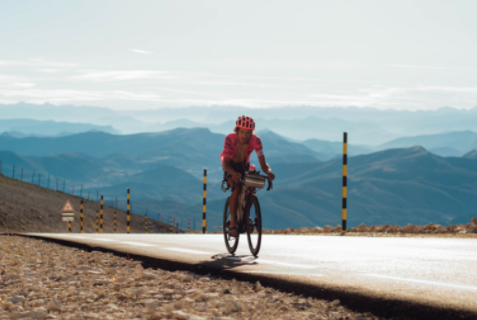
Alt Tour
In 2021, EF rider Lachlan Morton made headlines for riding the route of the Tour de France on his own. The transfers added an extra 2,100km, but he and his Birkenstocks still beat the pros to Paris. The aim of the Alt Tour was to recreate the ethos of the original Tours, where there were no transfers and riders completed a continuous loop of France. This wasn’t out of environmental conscience. When an early automobile tackled the first edition of Paris-Brest-Paris in 1891 it finished six days after the winning cyclist. That said, the route remained more or less continuous until the 1960s. Can we imagine bike racing without transfers? Gone would be the foreign grand départs and last-day dashes from Alpe d’Huez to the final stage in Paris. Gone might be the final stage in Paris. Can we imagine bike racing without flying? Interest in endurance events is sky high; the GBDuro, which Morton won in 2019, is a self-supported solo slog from Land’s End to John O’Groats. In 2020 it introduced a no-fly rule, with retired pro racer Svein Tuft riding to and from the event from his home in Andorra.
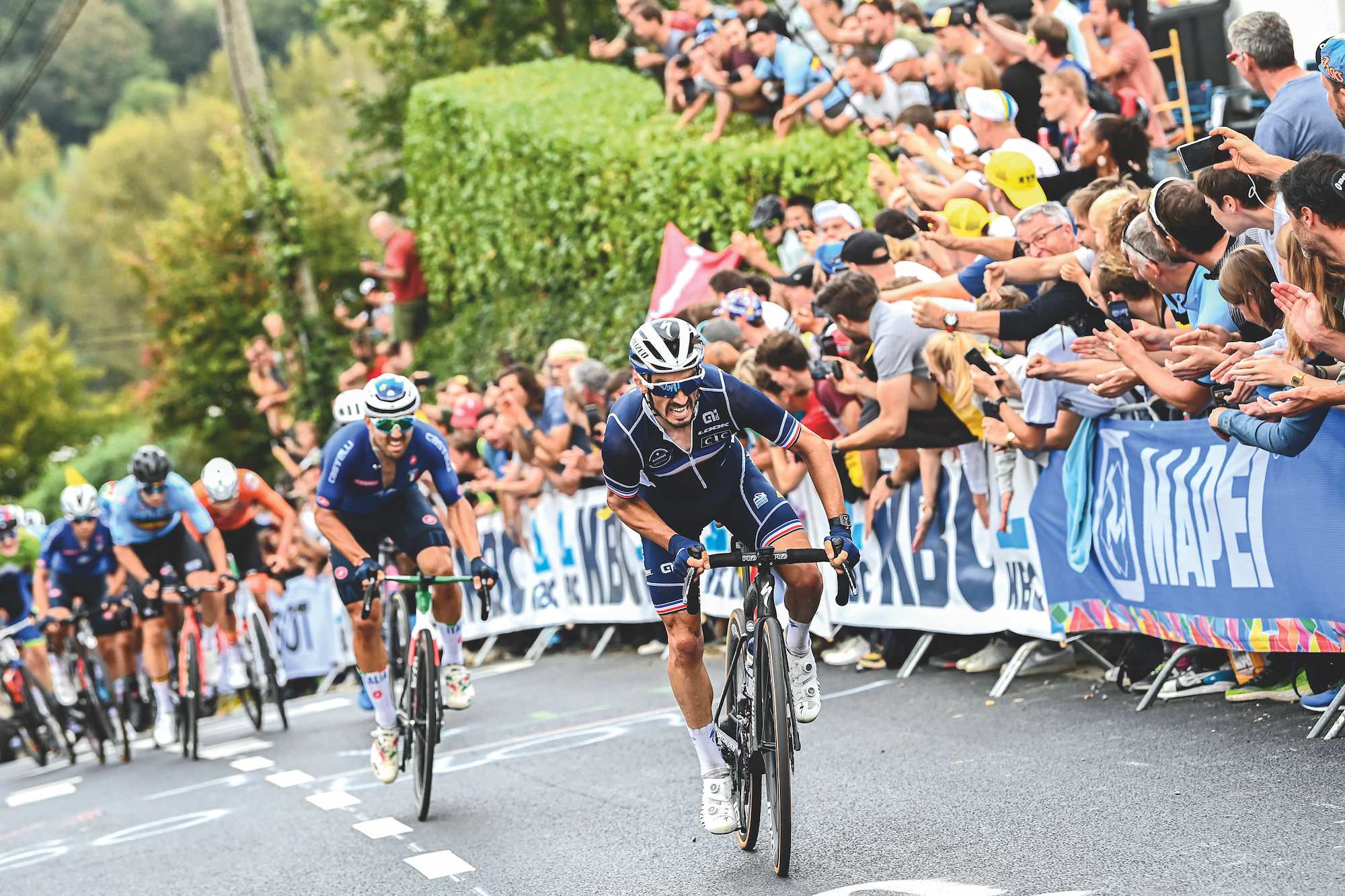
If I tell you where I’ve been. You might think I’ve lost my mind. I saw young folks fighting to save mother nature
Sooner or later humans will go extinct. At the end of the Anthropocene, our pale blue dot will return to a new balance. Life will go on evolving and the planet’s next sentient life form will dig down into the fossil record of the future and find the last remnants of homo sapiens: a thin layer of micro-plastics, a billion loom bands and the odd Tamagotchi. Perhaps they’ll wonder how we used to live, why we all carried trinkets of our gods (the Tesco Clubcard) and whether we had feathers.
I remember once seeing a cartoon where the subject, a person some years in the future, is reading a newspaper with the headline ‘Climate Deniers Proved Right!’ The caption reads something along the lines of: “What, so we created a better world for nothing?!”
Professional cycling accounts for a miniscule amount of emissions compared to the global total. And the sport is undoubtedly doing some good in the world by working to reduce its impact and encourage lots of people to ride bikes.
Yet it could do more. Lots more.
Mike Woods recalls a conversation with a former sports director on Slipstream who told him that if every rider on the team lived in Girona, the team’s main European base, for the duration of the European season then the money alone saved on flights would allow the team to travel private jet to every race, although obviously that wouldn’t be the best thing to do with the savings.
“From an entertainment perspective, our calendar is so all over the place that it makes it a very difficult narrative to follow,” Woods says. “We’re running three calendars on our team, with three or four races going on at the same time. To follow that as a fan makes no sense, but then think of the waste and money and environmental impact to run these three programmes. It’s wasteful.”
Just imagine how making changes to the sport could make it better all round. Imagine how, by making those changes, the sport could stand up and lead, to use its platform to do better for the world. Imagine how proud that would make us, the fans and the followers and the people for whom it means so much.
“A phrase I like to use regularly,” says Antoine Geerinckx from CO2logic, “is this: let everybody sweep in front of his door and the whole world will be clean. It’s a phrase from Von Goethe. It’s exactly the same for climate. Just imagine if everybody around the world took responsibility for their own emissions; a business, a person, a country. The climate problem would be solved.”
Professional cycling faces a climate emergency. But it also faces an opportunity. The sport needs to grasp it. Because soon we’ll be out of time.
This piece was first published in Pro Cycling magazine in the summer of 2021
